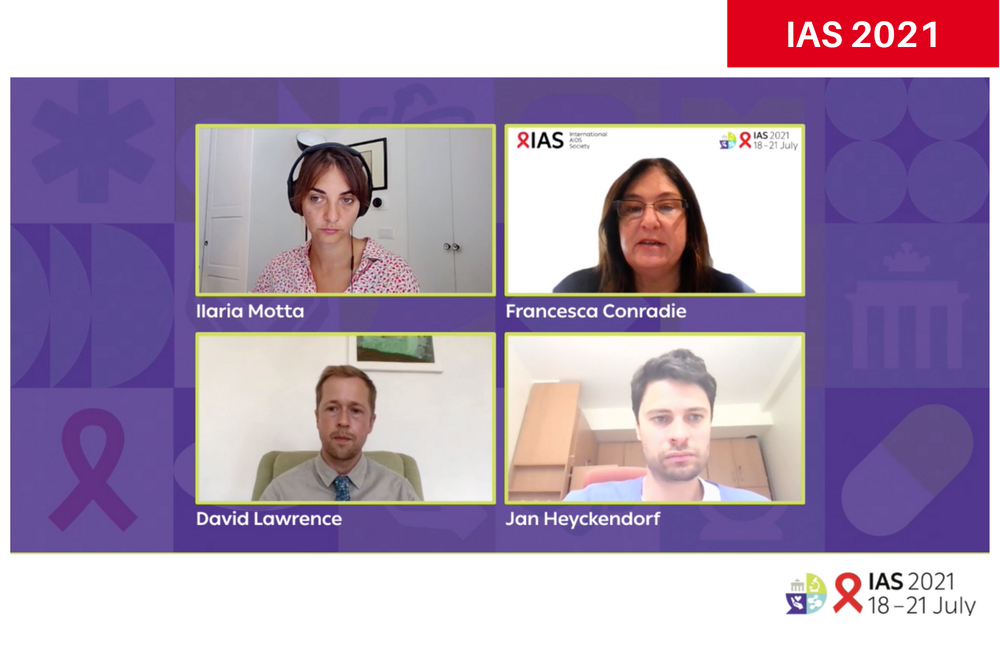
A six-month oral treatment regimen that limits exposure to the toxic drug linezolid can achieve a high cure rate in people with highly drug-resistant tuberculosis (TB), Dr Francesca Conradie of Sizwe Tropical Diseases Hospital, Johannesburg, told the 11th International AIDS Society Conference on HIV Science (IAS 2021) on Wednesday. Eighty-nine percent of study participants remained TB-free six months after completing treatment.
Dr Conradie was presenting the results of the ZeNIX trial, a study designed to optimise the six-month course of treatment with novel antibacterial drugs used to treat highly drug-resistant TB. Tuberculosis that is resistant to rifampicin or other core drugs in the four-drug first-line TB regimen must be treated with a combination of antibacterial drugs. If TB becomes resistant to fluoroquinolone antibacterials and any of the injectable drugs used in second-line TB treatment, it is classed as extensively drug-resistant (XDR) TB.
Most recommended regimens for treatment of multidrug-resistant (MDR) TB must be taken for at least nine months and some for up to 20 months. Some of the drugs used in MDR-TB treatment have serious toxicities and must be used with caution.
In 2020, the NIX-TB study showed that highly drug-resistant TB could be treated successfully with a six-month oral course of bedaquiline, pretomanid and linezolid (the BPaL regimen). Ninety percent of people who received the BPaL regimen remained free of TB six months after completing treatment.
However, study participants had a high frequency of serious side-effects due to linezolid. Eighty-one percent developed peripheral neuropathy (nerve damage in the limbs) and 48% developed myelosuppression (bone marrow suppression leading to severe reductions in red and white blood cells). Both side effects required dose reductions or interruption of linezolid.
To investigate whether the BPaL regimen could be made more tolerable without sacrificing efficacy, Conradie and colleagues carried out a successor study, ZeNix, in which participants received either a reduced dosage or a shorter duration of linezolid treatment.
ZeNix was a randomised, partially blinded study, in which all participants received bedaquiline and pretomanid, and were randomised to receive one of four linezolid treatment courses:
- Linezolid 1200mg daily for 6 months
- Linezolid 1200mg daily for 2 months
- Linezolid 600mg daily for 6 months
- Linezolid 600mg daily for 2 months
The study recruited people with XDR-TB (41%), people with MDR-TB that showed resistance to either a fluoroquinolone or an injectable TB drug (47%), people who had failed to respond to at least six months of standard MDR-TB treatment (6%) and people with rifamycin-resistant TB unable to tolerate drugs in the standard MDR-TB treatment regimen (5%). The study excluded people with prior exposure to any of the study drugs.
The study recruited 181 participants in Georgia (34), Moldova (10), Russia (71) and South Africa (66). Participants were predominantly male (67%), 36% were Black and 20% were living with HIV.
The primary endpoint of the study was the incidence of bacteriologic failure, relapse or clinical failure during treatment and up to six months after treatment completion.
"With a reduction in the dose and/or duration of linezolid, we can still offer patients a high chance of cure in only six months."
The primary efficacy analysis showed no significant difference in the treatment failure rate between study arms (93%, 88%, 90% and 84% had favourable outcomes in the respective study arms, an average of 89%). Participants in the linezolid 600mg for two months arm had a higher frequency of unfavourable outcomes (partially explained by withdrawals due to adverse events) but also had a slower time to culture negative status. This difference became evident after week 8 of the study, by which point half of participants in each arm were already culture negative.
The frequency of serious adverse events was lowest in the 600mg linezolid for two months study arm.
Peripheral neuropathy was reported in 38% of those receiving 1200mg of linezolid for six months; 24% of those receiving 1200mg of linezolid for two months; 24% of those receiving 600mg of linezolid for six months and 13% of those receiving 600mg of linezolid for two months. Four cases of optic neuropathy (damage to the optic nerve, affecting vision) occurred in the 1200mg linezolid for six months arm.
The frequency of anaemia, the most common manifestation of myelosuppression, was greater in the linezolid 1200mg arms (22% and 17% in the six-month and two-month arms respectively, compared to 2% and 7% in the linezolid 600mg six-month and two-month arms).
Modification of the linezolid dose occurred more frequently in the 1200mg arms. Fifty-one percent in the six-month arm and 28% in the two-month arm had to modify treatment or stop altogether because of side effects compared to 13% in the 600mg arms.
“The results of this study are very reassuring. With a reduction in the dose and/or duration of linezolid, we can still offer patients a high chance of cure in only six months,” Conradie said.
Responses to the experimental regimen were similar in people with HIV and the rest of the study population, she told a press briefing.
A second study of a six-month oral treatment regimen for MDR-TB, TB-PRACTECAL, was halted early in March 2021 because the experimental regimen showed superiority to the standard of care control treatment. The results of the study of a regimen consisting of bedaquiline, pretomanid, linezolid 600mg and moxifloxacin 400mg are likely to be published later this year. Trial sponsor Médecins Sans Frontières hopes the World Health Organization will change its guidance on MDR-TB treatment after reviewing the results.
Conradie F et al. High rate of successful outcomes treating highly resistant TB in the ZeNix study of pretomanid, bedaquiline and alternative doses and durations of linezolid. 11th IAS Conference on HIV Science, abstract OALB01LB02, 2021.
Update: Following the conference presentation, this study was published in a peer-reviewed journal:
Conradie F et al. Bedaquiline–Pretomanid–Linezolid Regimens for Drug-Resistant Tuberculosis. The New England Journal of Medicine, 387:810-823, September 2022.
DOI: 10.1056/NEJMoa2119430
